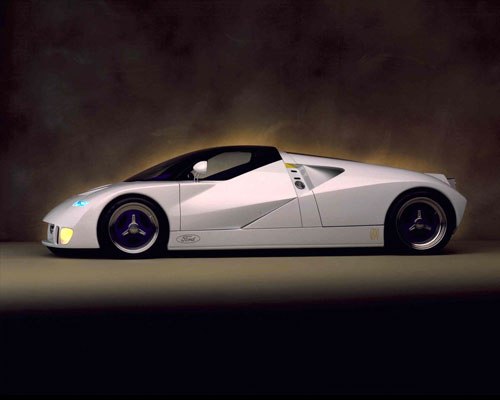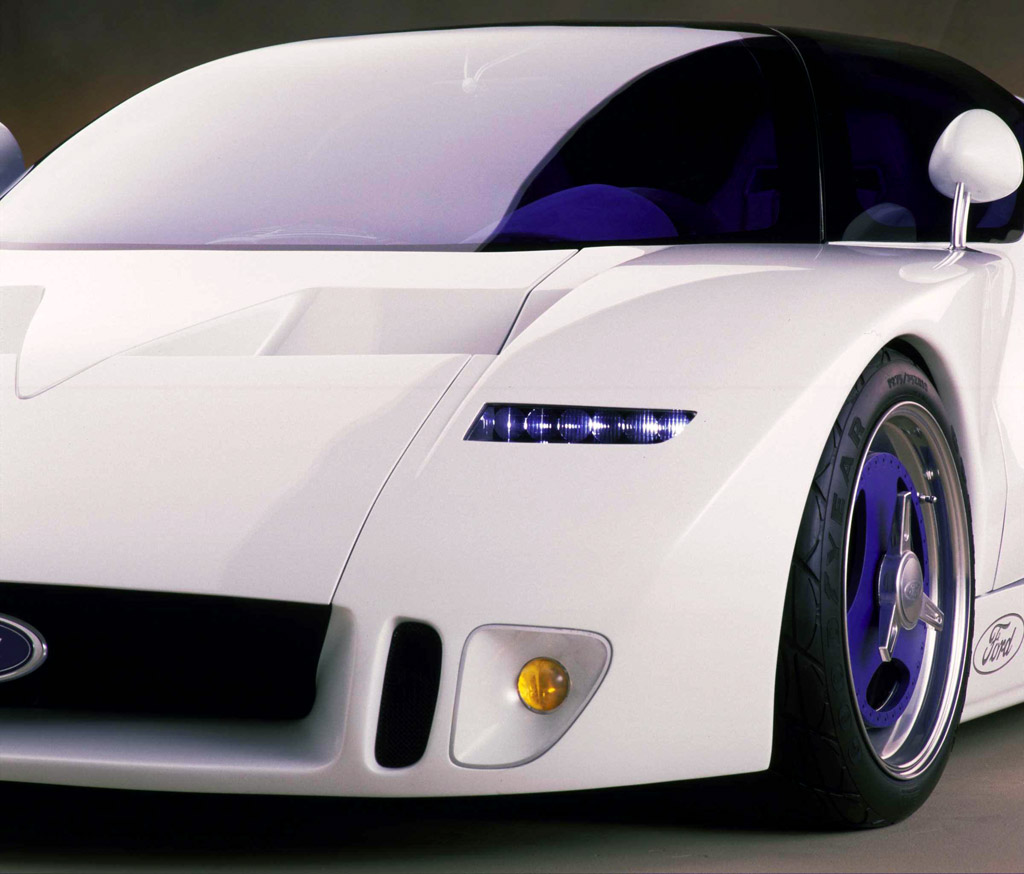The GT90 was a prototype car designed by Ford® in 1995 that would deliver on the dreams of an American made V12 mid-engine supercar — with quad (yes four) turbos pushing out over 700 horsepower and 660 foot pounds of torque. With an avante design approach, dubbed the “New Edge Philosophy” by Ford’s® design team, the GT90’s sweeping, Jaguar-esque aerodynamic nose is quickly transitioned into sharp profiles on the doors, feeding into the rear clamshell’s side air intake ducts. The rear incorporates an active aero rear spoiler that rests over a triangle shaped, four-port (four turbos!) exhaust system.
Ultimately the GT90 was a car decades before its time, with its aerodynamic body and massive horsepower for a production vehicle even by today’s standards.

So what happened to the GT90?
The GT90 was the unofficial successor to the GT40, albeit astute Ford fans will note that there was a GT70 and GT80 [abomination] as well. The GT90 was originally built as a competitor to the McLaren F1, with the team being led by the head of the SVT Special Vehicle Team, John Coletti. Coletti put together a team that engineered and assembled the GT90 in just six months by leveraging components with other Ford family vehicles, like the transmission and suspension from Jaguar XJ220 and the V12 engine being developed from modified Lincoln Town Car v8’s (4.0, not the 4.6). The heads were from were the 4-valve 4.6L heads, two of which were electron beam welded together for each side, fitted to a custom crankshaft and throwing in four Garrett T2 turbochargers to reach the massive 700 horsepower output.
Needless to say, the GT90 was put together in an incredibly short amount of time. Even with repurposing components from existing cars, the amount of engineering and fabrication required is astounding. Not to forget that they also created a quad-turbo V12 that is competitive by today’s standards. Unfortunately, this rapid production did not come with a perfect implementation — most notably the engine was not fully tuned, had a tendency to overheat, and got so hot that the exhaust pipes would melt the composite body. These are all engineering challenges that have been overcome in 2020, but in 1995 the GT90 was ushering in many new concepts into a street-driven vehicle.
While the design was polarizing, Ford would not provide an asking price to would-be GT90 owners, although they were rumored to be offered as low as $150,000 in 1995 — equivalent to $261,000 in 2022. Compared to the commanding $800,000 price-tag of it’s primary competitor, the McLaren F1, the economics of building a relatively inexpensive supercar simply might not have been feasible. As time passed, Ford decided that the GT90 would serve as their first example of their new design pattern found in many Ford’s of the 1990s and 2000s and that fans would have to settle for the dream of driving a GT90.
The GT90 Revisited After Three Decades
Any gamer from the mid-90’s will remember the GT90 being in Need for Speed II and Gran Turismo 2 and that’s about as close to the real thing that most car enthusiasts will get to enjoy. Given that there was only one GT90 ever produced, it certainly makes this V12 unicorn that much more elusive — and the internet abuzz with the fate of America’s V12 unicorn. From 1995 to 2009, the car hardly saw the light of day, stored away with other prototypes that were deemed unready or uncompelling to bring into full out production.
In 2009, fifteen years after inception, RM Auctions announced that the GT90 prototype would be auctioned in their 2010 Arizona auction. This would be the first time that someone from the public would get the opportunity to own and drive the notorious V12. Notable highlights from the original listing from RM Auctions include:
Est. 720 bhp, 6.0 liter quad-turbocharged mid-engine V12, five-speed manual gearbox, four-wheel independent suspension, and four wheel ventilated disc brakes. Wheelbase: 116″
The one-off GT90 Concept Car, labeled immediately as “the world’s mightiest supercar” by Ford Motor Company on December 6, 1994, was the spiritual successor to the Ford GT40, the product of a colossal feud in the early 1960s between the Blue Oval from Dearborn and the Prancing Horse of Northern Italy. The GT90 draws from the design cues of its heritage and pays homage to the famed Le Mans-winning Ford GT40s of the 1960s, which were created after the failed attempt by Ford to buy out Ferrari.
RM further goes on to define the GT90 development and production:
At a development cost in the neighborhood of $3 million, the GT90 was certainly worthy of pulling styling cues from the original Ford GTs, and although it was never meant for production, it was built according to a Ford press release as a “test bed for technology, engineering and design concepts, and driver-oriented features that eventually may be used in Ford production vehicles.”
Officially unveiled to the public in January 1995 at the Detroit Auto Show, the GT90 is finished in bright white with a bright blue and carbon fiber interior. It features a mid engine quad-turbocharged V12 that produces an estimated 720 horsepower and 660 pound-feet of torque. As a result, it had a claimed top speed of 253 mph, which even by today’s standards would make it one of the fastest production cars in the world – faster even than a McLaren F1, which was widely considered the world’s preeminent supercar at the time.
However, the car never made it to auction, being pulled a few weeks before the auction started. The elusive GT90 would slip away from the public’s eye again for nearly a decade.
So where is the GT90 today?
In 2018, YouTube videos started to surface of the GT90 running In 2020, Hemmings muses about the GT90 and the time since past — at this point three decades since it originally debuted. The car still commands interest of those who seek the ever elusive American V12 supercar, ironically commenting at how casually the GT90 was presented to would-be owners and fascinated on-lookers — ultimately never available for purchase.
Conclusively we can say that the prototype now resides at Hajek Motorsports Museum in Ames, Oklahoma. It is alive and running and can occasionally be seen at local Cars & Coffee meetups.
Is There a Future For the GT90?
Insane things can happen when you get the right group of car guys together that love to push the envelope.
A wishlist of things to improve upon from the 1995 Ford GT90
- Simplicity: by today’s standards, the quad turbo is redundant with today’s turbo technology (2022 at time of writing this) — it makes much more sense to go with a twin turbo setup utilizing twin-scroll turbochargers.
- More power: V12’s are proven and capable of high revs, like Pagani’s 9000rpm monster. With higher revs and an upgraded turbocharger system, there’s no reason why a reliable and ear-gasmic 1000 horsepower can’t be seen from the powertrain.
- More gears: retaining the V12 is a must-have, but it’s time to ditch the five speed and jump into a seven speed. These are available in both manual and dual clutch transmissions which would give the owner the choice between a more traditional H-pattern box or a sequential shifting approach that ensures that the gears will never be mashed.
- Cooling and lubrication: the original GT90 has to resort to ceramic tiles being used to help protect the carbon body from the engine’s exhaust temperatures. The car was criticized as being unreliable due to poor heat management, making it unruly for the road. Modern problems require modern solutions — high-temperature prepreg composites and aerospace grade thermal insulation would keep everything light and true.
- An upgraded interior: the blue interior is polarizing and whether you love or hate it can certainly be off-putting. Having the option for a black interior would certainly highlight the the original hints of carbon and raw aluminum, which are still inspiring by today’s design standards. The steering wheel needs to be redone in carbon fiber and have thumb controls included for aero and suspension settings.
GT90 Specs
Overview
| Type | Concept / Prototype Car |
| Released at | 1995 NAIAS |
| Built at | Detroit, USA |
| Power | 720.0 bhp / 536.9 kw @ 6600 rpm |
| Torque | 660.0 ft lbs / 894.8 nm @ 4750 rpm |
| Curb weight | 3199 lbs / 1451 kg |
| Wheelbase | 116.0 in / 2946 mm |
| Front track | 176.0 in / 4470 mm |
| Width | 77.3 in / 1963 mm |
| Height | 44.9 in / 1140 mm |
Powertrain
| Engine | V12 |
| Transmission | FFD-Ricardo 5-Speed Manual |
| Aspiration | Four Garrett Systems T2 Turbochargers |
| Valvetrain | DOHC 4 valves per cylinder |
| Displacement | 5927 cc / 361.7 in^3 |
| Bore | 3.55 in / 90.2 mm |
| Stroke | 3.04 in / 77.3 mm |
| Compression | 8.0:1 |
| Specific output | 121.48 bhp per liter |
| BHP/weight | 496.21 bhp per ton |
| Body / frame | Carbon fiber & fiberglass |
Wheels & Brakes
| Driven wheels | Mid-engine / RWD (MR) |
| Front tires | F 275/35ZR-18 |
| Rear tires | R 355/30ZR-19 |
| Front brakes | Vented discs |
| Rear brakes | Vented discs |
| Front wheels | F 45.7 x 50.8 cm / 18.0 x 20.0 in |
| Rear wheels | R 48.3 x 66.0 cm / 19.0 x 26.0 in |
Steering & Suspension
| Steering | Rack & Pinion with power assist |
| Front suspension | Jaguar XJ220 Wishbones |
| Rear suspension | Jaguar XJ220 Wishbones |
Performance
| Top speed | 253 mph / 407 kph (theoretical) |
| 0 – 60 mph | ~3.1 seconds |
| 0 – 100 mph | ~6.2 seconds |
| 0 – 1/4 mile | ~10.9 seconds |











